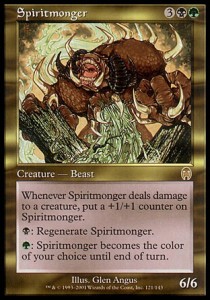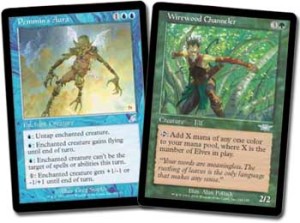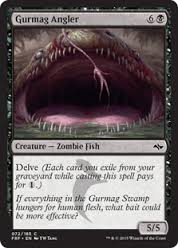
No matter the stakes, no matter the format, the only thing you’ll find in this player’s hands is a brew. It might be the pet deck they’ve been tweaking and tuning for months, or it might be something new and spicy every week. Either way, playing a popular or “tier 1” deck is completely off the table for this kind of magic player. In the competitive magic scene you might call this kind of player insane, but for the sake of simplicity I’ll refer to them as a “brewer”.
If you’re an active member in your local magic community, chances are good that you can picture several players who fit this description. If one of those players is you, then you’ve come to the right place. This article series will be all about testing and analyzing brews with competitive promise. Being a brewer doesn’t disqualify you from being competitive, it just means that for one reason or another you simply have to win with something different.
Do you have a reason for being a brewer? Is it pride? Budget? A desire to be unique?
For me, brewing has always been an elementary decision.
My Magic Origins
I learned to play Magic in 4th grade while attending a small private school. Almost half of the boys in my class would play Magic during recess. I remember that my only decks were mono green 7-drops and five color slivers, that Spiritmonger dominated the recess meta, and not much else from this era.

In 6th grade I moved to a larger and significantly less nerdy school, where none of my new classmates knew how to play Magic. Without other kids to play the game with me, I spent the majority of my formative magic years designing new decks and posting them on internet forums. Brewing decks and arguing with strangers on the internet was the only way for me to stay in touch with the game I loved, so that’s what I did.
Since I spent more time designing decks than actually playing the game, I completely lacked the context for which strategies and cards were effective in practice. My first question when looking at a new card wasn’t “is this good?”, it was “how can I break this?”. I was a brewer without a cause. Consequently, I tended to build linear, fragile, and complicated decks that were fun to goldfish but rarely competitive. Though I’ve since shifted my focus towards competitive decks, deep down I’m still the kid who’s wondering “how can I break this?”.
I attended only one constructed tournament before returning to Magic during RTR block, it was an Onslaught/Mirrodin standard event the week after Mirrodin’s release. As a 12 year old with virtually no practice against real opponents, I was thoroughly convinced that the deck I had stumbled on was completely unbeatable. Over a decade later I still remember the tournament like it was yesterday.
Some of you old school players might remember the deck I brought. Its goal was to make infinite mana with Wirewood Channeler, an elf, and a Pemmin’s Aura, then use some combination of Aphetto Alchemist, Viridian Longbow, and Wellwisher to deal infinite damage or gain infinite life, and Xanthid Swarm to protect itself.

Though I didn’t win the tournament (I believe I finished 2-2), I had tasted the sweet joy of going infinite against an unsuspecting opponent. In a weird way, I enjoyed the deck I played that day more than I enjoyed the game of Magic itself. It felt like my opponents were playing Magic the way it was intended to be played, while I was meddling with something entirely different and more nefarious. Piloting the deck made me feel like an evil villain that was building a doomsday device, and I loved every second of it.
To me, the game of Magic and the act brewing are inextricably tied. I played a janky brew at my first ever competitive tournament, and have played janky brews at every competitive event since.
Winning with Brews
Can you truly be a brewer, and a spike? Let’s start with the facts.
Fact #1 – The majority of top magic professionals only play tiered decks at tournaments.
Most of today’s top players will test, tune, and practice almost exclusively with decks that have already proven themselves to be winners. The logic here is sound – if you aren’t spending your time on designing and testing new decks, you can get in way more reps with the established deck of your choice.
Without question, playing tiered decks is the safest and easiest way to take down a tournament. I’m not here to convince anyone to be a brewer by outlining the competitive benefits of brews, because that would be foolish. A true brewer requires no convincing to eschew conventional wisdom.
Fact #2 – Brews win major tournaments.
At Pro Tour Battle for Zendikar, Sam Black and his team played a Bant Tokens list of his own design which posted the single highest win percentage of any deck at the Pro Tour. Let that sink in, a brew was the best deck at the most recent Pro Tour. True to his form as a brewer, Sam was making changes to his deck all the way up to the morning of the Pro Tour.
Sam’s Bant Tokens deck isn’t the only brew to put up results at a big tournament, nor will it be the last. To provide another recent example, Zac Elsik took down Grand Prix Oklahoma City with his Lantern Control deck. Though they’ll never account for as many tournament wins as tiered decks, brews are unquestionably capable of bringing home a trophy.
Fact #3 – Some of the world’s best Magic players are stubborn brewers.
Sam Black, Patrick Chapin, Jeff Hoogland, and many others successful pros design their own decks, bring them to tournaments, and post strong results with them.
Patrick Chapin, known as “The Innovator”, has arguably had a much larger impact on the game of Magic with his deck construction skills than with his tournament results. Patrick is well known for his ability to discover powerful cards and play them in decks of his own design long before they gain popularity. This gives him a serious edge on the competition in open metagames, especially after a new set is released.
After several strong finishes with his Grixis Control deck Patrick’s former brew is now a mainstay of the Modern metagame, and Gurmag Angler is a multi-format force to be reckoned with. In my own opinion, introducing a new card or deck to the zeitgeist of competitive Magic is a far more impactful accomplishment than winning a GP. To accomplish both in one fell swoop, as Zac Elsik did with his Lantern Control deck, is the brewer’s wet dream.
Can you be a brewer and spike? Absolutely. The real question is a little more complicated that. If you’ve already made the decision to be a brewer, how can you leverage that into a competitive advantage?
The Brewer’s Edge
In a recent Standard PPTQ I played a brew which I registered as “Esper Green Tokens”, and finished the tournament in 2nd place. The deck was similar to the Esper Tokens list that is currently played in Standard, but splashed green for 4 maindeck copies of Abzan Charm.
Even though Abzan Charm was the only green card in the deck, my opponents would look at the lands I had in play and put me on Siege Rhino, making game decisions as though Rhino was all but guaranteed to be in my hand. How am I so sure this happened? A couple of my opponents that day asked me about the Rhinos that never came while we were between games, perhaps hoping to gain some sideboarding insight.
“Did you not draw any of your Rhinos that game?” asked one opponent after a long and grindy game one against Abzan.
“Yeah, didn’t draw any Rhinos that game.” I replied, truthfully.
There are several key advantages to fielding a brew over tiered decks. The largest of which is the practice advantage you will have against the majority of your opponents. When your opponent has never played against your deck before, they are much more liable to make poor strategic decisions. It’s easy to know who’s the beatdown when you’ve played a matchup several dozen times, but how do you confidently make that evaluation when you don’t even know what cards are in your opponent’s deck? Incorrectly evaluating your role in a matchup can lead to critical strategy errors, and critical strategy errors can be easily leveraged into a victory.
Another major advantage to playing brews is the lack of knowledge your opponent will have on the individual cards in your deck. Even if you’re only playing a modified version of an existing deck (like my Esper Green Tokens list), opponents of a brew are forced to play around a wider range of cards. This is especially true after sideboarding, and its all too common for me to hear my opponents remark that they lost a game because they played around the wrong card.
Brews force your opponents to make uncomfortable decisions, and uncomfortable decisions lead to mistakes. As a lifelong brewer, I can confidently say that these mistakes have accounted for several points of my overall competitive win percentage. In competitive magic, a couple of percentage points is all it takes to separate the good players from the great ones.
The Brewer’s Dilemma
In reality, most brewers probably don’t consider the competitive advantages and disadvantages to brewing when choosing their deck. To play Magic is to brew, prevailing wisdom be damned.
I justify my competitive brewing habits by my belief in this principal:
The “best deck” to win a given tournament does not currently exist. If the “best deck” does currently exist and can be prepared for, then by definition it is no longer the best deck to win a tournament.
This so-called “best deck” will almost never be a tier 1 deck, since tier 1 decks are thoroughly expected and prepared for (possible exceptions to this might be pre-ban standard decks such as Affinity and Caw Blade, where the power level of certain cards were simply too oppressive for other decks to keep up with). In the abstract, the best deck to take down a tournament is always dependent on the current state of the metagame, and will employ the strategy that attacks the highest percentage of decks that will be at the tournament.
As a thought experiment, imagine a meta that consisted only of Infect decks. The best deck in this meta-from-hell wouldn’t be a tiered strategy with a plus matchup against Infect, it’d be some funny pile of cards that main-decked 4 copies of Melira, Sudden Shock, and Pyroclasm. See where I’m going with this?
Herein lies the brewer’s dilemma. If you believe there’s always a better deck out there than what currently exists, will you really be the one to find it? If you can find it like Sam Black did at Pro Tour BFZ, there payoff is there. If you can’t, then you probably would have been much better suited playing an established deck. For every Bant Tokens list there’s a long list of brews that fell flat.
Mono Brew #2?
I hope you enjoyed my brewer’s manifesto! Going forward, Mono Brew will focus on analyzing, dissecting, and testing brews with competitive promise. I’ll pick a brew, test it against the top decks in the meta, and give my opinion on whether or not it can hang with the tier 1 overlords. Feel free to shoot me an email at [email protected] if you have a Modern or Standard deck you’d like me to consider for this series.
What constitutes a brew? To borrow the supreme court’s definition of pornography, I know it when I see it. As a general guideline, hop on to mtggoldfish and check out the first page of decks. If you don’t see the deck you’re thinking of then it’s probably safe to call it a brew.
In the spirit of the holidays, I’ll be “Bringing Gifts” to Brainstorm Brewery very soon. Stay tuned for a full primer on my Modern pet deck – 5 color Gifts Ungiven with Bring to Light!
Happy Brewing,
Aleco Pors

